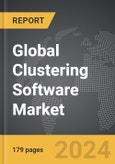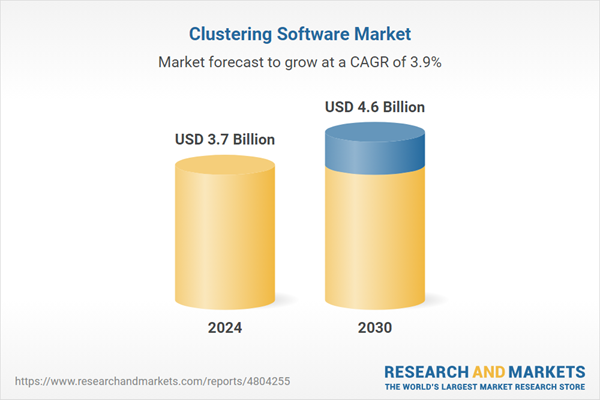Global Clustering Software Market - Key Trends and Drivers Summarized
Why Is Clustering Software Becoming Essential for High-Performance Computing?
Clustering software has become a cornerstone of high-performance computing (HPC), enabling businesses and research institutions to process large-scale datasets and perform complex computations across multiple machines as if they were a single system. But why has it become so essential? At its core, clustering software allows multiple computers (often referred to as nodes) to work together in parallel, sharing computational tasks and resources such as CPU, memory, and storage. This makes it ideal for industries dealing with vast amounts of data or requiring intensive computational power, including scientific research, financial modeling, healthcare, and engineering. As data generation grows exponentially in fields like genomics, artificial intelligence, and climate modeling, the demand for clustering software has surged. By distributing workloads across a network of machines, clustering software significantly reduces the time required to process data and perform calculations, enabling organizations to derive insights faster and more efficiently. In today's world, where businesses and institutions need to process increasingly complex tasks, clustering software is no longer a niche tool but a critical part of modern computing infrastructure.What Technologies Are Fueling the Evolution of Clustering Software?
The evolution of clustering software has been fueled by a combination of advanced technologies that have significantly enhanced its capabilities. One of the most important developments is in the field of virtualization and containerization, which allows workloads to be isolated, optimized, and distributed across clusters without compatibility issues. Technologies like Docker and Kubernetes have become key enablers of clustering, allowing for seamless management of workloads and services across multiple nodes. These tools enable the automation of scaling, failover, and resource allocation, which makes it easier for organizations to manage large-scale clusters efficiently. Furthermore, advancements in networking technologies, such as high-speed interconnects like InfiniBand and Ethernet, have enhanced communication between nodes, reducing latency and improving the performance of clusters. As a result, clustering software can now support larger clusters with more nodes, enabling even greater computational power. The rise of cloud computing has also played a pivotal role in the growth of clustering software, with cloud platforms like AWS, Microsoft Azure, and Google Cloud offering scalable clustering solutions that can be provisioned on demand. This allows organizations to tap into massive computational resources without the need for significant capital investment in on-premises hardware. Finally, machine learning and artificial intelligence are increasingly being integrated into clustering software to optimize resource allocation, predict potential bottlenecks, and enhance overall performance. These technologies allow clusters to self-optimize, ensuring that they operate at peak efficiency even as workloads evolve.How Are Different Industries Leveraging Clustering Software?
Clustering software is being adopted by a wide range of industries, each leveraging the technology to meet specific computational challenges. In the field of scientific research, for instance, clustering software is used extensively in simulations, data analysis, and complex calculations. From modeling climate change to analyzing genetic sequences in genomics, researchers rely on clustering software to process massive datasets that would be impossible to handle on a single machine. In finance, institutions are using clustering software to run complex financial models and simulations, which are essential for risk management, portfolio optimization, and algorithmic trading. The ability to process large amounts of data in real-time allows financial firms to make faster and more informed decisions. In the healthcare sector, clustering software is powering breakthroughs in drug discovery, medical imaging, and personalized medicine. By enabling faster data processing and simulations, clustering software allows researchers to develop new therapies and analyze vast amounts of patient data more efficiently. Engineering and manufacturing companies are also adopting clustering software for tasks like computer-aided design (CAD), fluid dynamics simulations, and materials testing. These industries benefit from the ability to perform detailed simulations at scale, allowing them to optimize designs and reduce time-to-market. Additionally, the entertainment industry has increasingly turned to clustering software for visual effects (VFX) rendering and animation. With the ability to process high-resolution images and complex 3D models, clustering software helps film and game studios render scenes faster and with more detail than ever before.What Are the Factors Fueling Expansion of the Clustering Software Market?
The growth in the clustering software market is driven by several factors that reflect broader trends in data processing, computational demands, and technological advancements. One of the key drivers is the explosion of big data across industries. As organizations generate and collect more data than ever before, there is a growing need for computational solutions that can process this data efficiently. Clustering software provides a way to distribute workloads across multiple machines, allowing organizations to handle larger datasets and more complex computations without the need for costly supercomputers. Another significant growth driver is the rising demand for high-performance computing (HPC) in industries like healthcare, engineering, and finance, where simulations, modeling, and data analysis are critical to success. The need to process complex calculations quickly has pushed these industries to adopt clustering software as a more cost-effective alternative to building large, centralized computing systems. The rise of artificial intelligence and machine learning is another major factor fueling the growth of clustering software. As AI algorithms become more advanced and data-intensive, the ability to distribute processing tasks across clusters of machines is crucial for training models and running inference tasks at scale. Additionally, the increasing adoption of cloud computing is making clustering software more accessible to businesses of all sizes. Cloud platforms offer scalable and flexible clustering solutions that allow companies to leverage vast computational resources without the need for significant upfront investment in hardware. Lastly, the growing trend toward hybrid cloud environments, where organizations use a combination of on-premises and cloud resources, is further driving the demand for clustering software that can seamlessly manage workloads across different infrastructure types. These factors, combined with continuous advancements in networking and virtualization technologies, are positioning clustering software as a critical tool for modern data processing and computational needs.Report Scope
The report analyzes the Clustering Software market, presented in terms of market value (USD). The analysis covers the key segments and geographic regions outlined below.- Segments: Segment (Clustering Software).
- Geographic Regions/Countries: World; United States; Canada; Japan; China; Europe (France; Germany; Italy; United Kingdom; and Rest of Europe); Asia-Pacific; Rest of World.
Regional Analysis
Gain insights into the U.S. market, valued at $981 Million in 2024, and China, forecasted to grow at an impressive 3.8% CAGR to reach $741.4 Million by 2030. Discover growth trends in other key regions, including Japan, Canada, Germany, and the Asia-Pacific.Why You Should Buy This Report:
- Detailed Market Analysis: Access a thorough analysis of the Global Clustering Software Market, covering all major geographic regions and market segments.
- Competitive Insights: Get an overview of the competitive landscape, including the market presence of major players across different geographies.
- Future Trends and Drivers: Understand the key trends and drivers shaping the future of the Global Clustering Software Market.
- Actionable Insights: Benefit from actionable insights that can help you identify new revenue opportunities and make strategic business decisions.
Key Questions Answered:
- How is the Global Clustering Software Market expected to evolve by 2030?
- What are the main drivers and restraints affecting the market?
- Which market segments will grow the most over the forecast period?
- How will market shares for different regions and segments change by 2030?
- Who are the leading players in the market, and what are their prospects?
Report Features:
- Comprehensive Market Data: Independent analysis of annual sales and market forecasts in US$ Million from 2024 to 2030.
- In-Depth Regional Analysis: Detailed insights into key markets, including the U.S., China, Japan, Canada, Europe, Asia-Pacific, Latin America, Middle East, and Africa.
- Company Profiles: Coverage of players such as Fujitsu Ltd., Hewlett-Packard Development Company LP, IBM Corporation, Microsoft Corporation, NEC Corporation and more.
- Complimentary Updates: Receive free report updates for one year to keep you informed of the latest market developments.
Some of the 12 companies featured in this Clustering Software market report include:
- Fujitsu Ltd.
- Hewlett-Packard Development Company LP
- IBM Corporation
- Microsoft Corporation
- NEC Corporation
- Oracle Corporation
- Red Hat, Inc.
- Silicon Graphics International Corporation
- Symantec Corporation
- Vmware, Inc.
This edition integrates the latest global trade and economic shifts into comprehensive market analysis. Key updates include:
- Tariff and Trade Impact: Insights into global tariff negotiations across 180+ countries, with analysis of supply chain turbulence, sourcing disruptions, and geographic realignment. Special focus on 2025 as a pivotal year for trade tensions, including updated perspectives on the Trump-era tariffs.
- Adjusted Forecasts and Analytics: Revised global and regional market forecasts through 2030, incorporating tariff effects, economic uncertainty, and structural changes in globalization. Includes historical analysis from 2015 to 2023.
- Strategic Market Dynamics: Evaluation of revised market prospects, regional outlooks, and key economic indicators such as population and urbanization trends.
- Innovation & Technology Trends: Latest developments in product and process innovation, emerging technologies, and key industry drivers shaping the competitive landscape.
- Competitive Intelligence: Updated global market share estimates for 2025, competitive positioning of major players (Strong/Active/Niche/Trivial), and refined focus on leading global brands and core players.
- Expert Insight & Commentary: Strategic analysis from economists, trade experts, and domain specialists to contextualize market shifts and identify emerging opportunities.
Table of Contents
Companies Mentioned (Partial List)
A selection of companies mentioned in this report includes, but is not limited to:
- Fujitsu Ltd.
- Hewlett-Packard Development Company LP
- IBM Corporation
- Microsoft Corporation
- NEC Corporation
- Oracle Corporation
- Red Hat, Inc.
- Silicon Graphics International Corporation
- Symantec Corporation
- Vmware, Inc.
Table Information
| Report Attribute | Details |
|---|---|
| No. of Pages | 179 |
| Published | December 2025 |
| Forecast Period | 2024 - 2030 |
| Estimated Market Value ( USD | $ 3.7 Billion |
| Forecasted Market Value ( USD | $ 4.6 Billion |
| Compound Annual Growth Rate | 3.9% |
| Regions Covered | Global |









